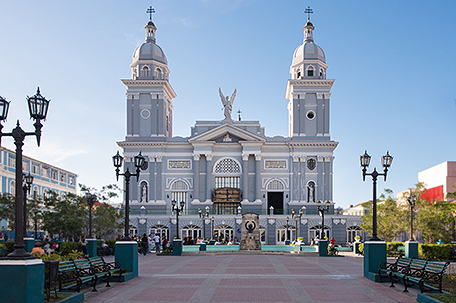
ABOVE PHOTO: Santiago Cathedral (Photo: shutterstock)
By Renée S. Gordon
“In Latin America, all of history coexists at once.” –Brin-Jonathan Butler
In 1492, Christopher Columbus “discovered” an island he named Juana on his first voyage Cuba, a variant of Cubanascan, which is the name given by the indigenous people. Four million U.S. citizens rediscovered the 42,815-sq.mile island 525-years later. Cuba is actually a 776-mile long archipelago set amidst thousands of smaller islands. Geographically it is 112-miles from Florida and 50 miles from Jamaica. It is comprised of beaches, marshes, mountains, plains and tropical forests, and is situated between North and South America at the mouth of the Gulf of Mexico. While the dominant culture is Spanish, the evidence of African, Chinese and other Europeans’ profound cultural influence on Cuba’s art, architecture, cuisine, religion and music is pervasive.
The first settlement was founded in 1511, the same year Taino Chief Hatuey led a rebellion against the Spanish resulting in his being burned at the stake. In 1512, the King of Spain officially sanctioned Black slavery, and by 1555 their number exceeded 750. Ultimately, more than a million slaves were brought to Cuba and by 1830, the Black population outnumbered that of whites. Their labor made Cuba the world’s leading sugar manufacturer at every stage of production. Slavery was abolished in 1886.
Potential visitors tend to comment that they wish to visit Cuba and see it before it changes. I disagree, Cuba is like a kaleidoscope with fixed elements that are always expanding and morphing into something equally spectacular and a constant surprise. Additionally, one of Cuba’s greatest exports has always been its culture. Think Gloria Estefan, Desi Arnez, Celia Cruz, Mojitos and the rumba, and we begin to realize that visiting Cuba is like spending time with an old friend. In short, Cuba is where passion, art and history intersect, and this is the perfect time to take in all it has to offer.
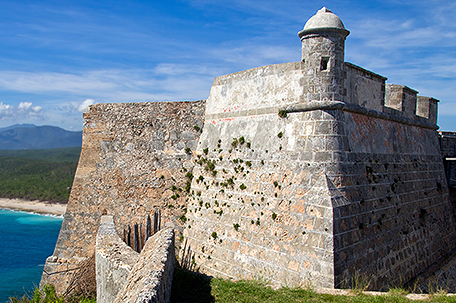
Castle Morro (photo: shutterstock)
To maximize your experience, I highly recommend a cruise to the island. My research found that the best way to experience all that Cuba offers — is to take a cruise. The most affordable and immersive all island tour I found was Celestyal® Cruises “Experience The Real Cuba.” All of the above sites are part of a Havana tour in conjunction with accompanying guides, specialty drinks and guaranteed access to sites. All of their cruises immerse you in the culture through more than port excursions. On board activities and events enhance your experience with lectures, classes, and folklore presentations. Most impressively, activities are designed to coincide with port visits so that travelers are knowledgeable prior to cultural encounters. Celestyal Cruises vary in length and ports of embarkation. Schedules, general information and pricing is available online. (http://americas.celestyalcruises.com/en, #celestyalcruises)
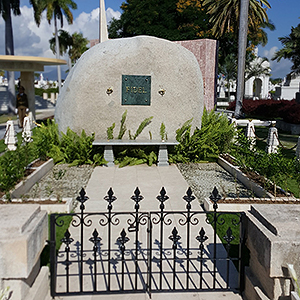
Fidel Castro’s grave
There are nine UNESCO World Heritage sites in the country, and the three harbors in which the ship docks provide access to five of them. The first port of call is Santiago de Cuba, one of the earliest settlements, established by Diego Velázquez de Cuéllar on June 28, 1514. Both Hernán Cortés and Hernando de Soto embarked on expeditions from Santiago, and from 1522-89 it was the colony’s capital.
The premiere site in the city is the UNESCO inscribed Castillo San Pedro de la Roca, the 17th century fortress. The cliff side structure, designed by Giovanni Antonelli is considered “the most complete, best-preserved example of Spanish-American military architecture, based on Italian and Renaissance design principles.” Tours include museum rooms and outdoor areas accessed by a series of stone steps and ramparts. The views are incredible and include the Sierra Maestra Mountains in which revolutionaries were headquartered.
Northwest of the city is Santa Ifigenia Cemetery, founded in 1868. It is named after an Ethiopian saint. The cemetery is replete with magnificent marble mausoleums, monuments and gravesites. Fidel Castro is interred here in a tomb carved from rock from his headquarters in the Sierra Maestra Mountains, as well as the ashes of José Martí, national hero, poet and revolutionary. Martí’s 85-ft. tall, hexagonal mausoleum sits upon soil from every Latin American country, and a changing of the guard ceremony takes place daily.
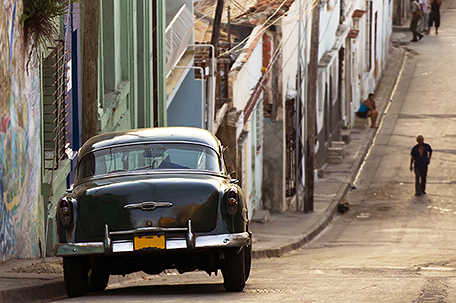
A classic Chevrolet car in the streets of Santiago. (photo: shutterstock)
Theodore Roosevelt solidified his reputation during the Spanish American War by recruiting a group of amateurs he dubbed “The Rough Riders” to fight. On July 1, 1898, “The Rough Riders” and the 10th Cavalry of the US Colored Troops — the Buffalo Soldiers — charged up San Juan Hill, leading to a decisive Spanish defeat. The Buffalo Soldier’s contribution has gone largely unnoticed. Today the hill is covered with monuments, the centerpieces of which are a centennial monument and a reproduction blockhouse.
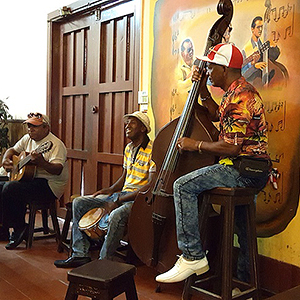
Local Santiago musicians.
Santiago is known as the “Cradle of the Revolution,” because significant events took place there. The Cuban Revolution began with informal urban resistance which was unified on July 26, 1953 when Fidel Castro led 150 rebels to attack Moncada Fort. Bullet holes are still visible on the exterior. Four years later, Castro announced victory from the balcony of City Hall.
The heart of Santiago is Céspedes Park, built according to the law at the time, surrounded by the cathedral, town hall and homes of the wealthy. The existing cathedral dates from 1727, and is a mixture of architectural styles. Of particular note is a statue of Columbus in a niche inside.
Possibly the oldest home in the country, the 1516-30 home of Diego Velazquez is now a museum. The house has Moorish elements and a cedar roof. Velazquez’s office was on the ground floor.
Santiago is considered one of Cuba’s most afrocentic cities, and the annual carnival puts Afro-Cuban culture on display. The carnival dates from the late 1600s, and includes, parades, performances and the official dance, the conga.
We will move on to Havana in Part Two. Get ready to take a ride in American classic cars, sip a mojito to the vibrant music of the Buena Vista Social Club and end your evening in the country’s biggest nightclub, the internationally famous Tropicana. Prepare to be amazed.

















Leave a Comment